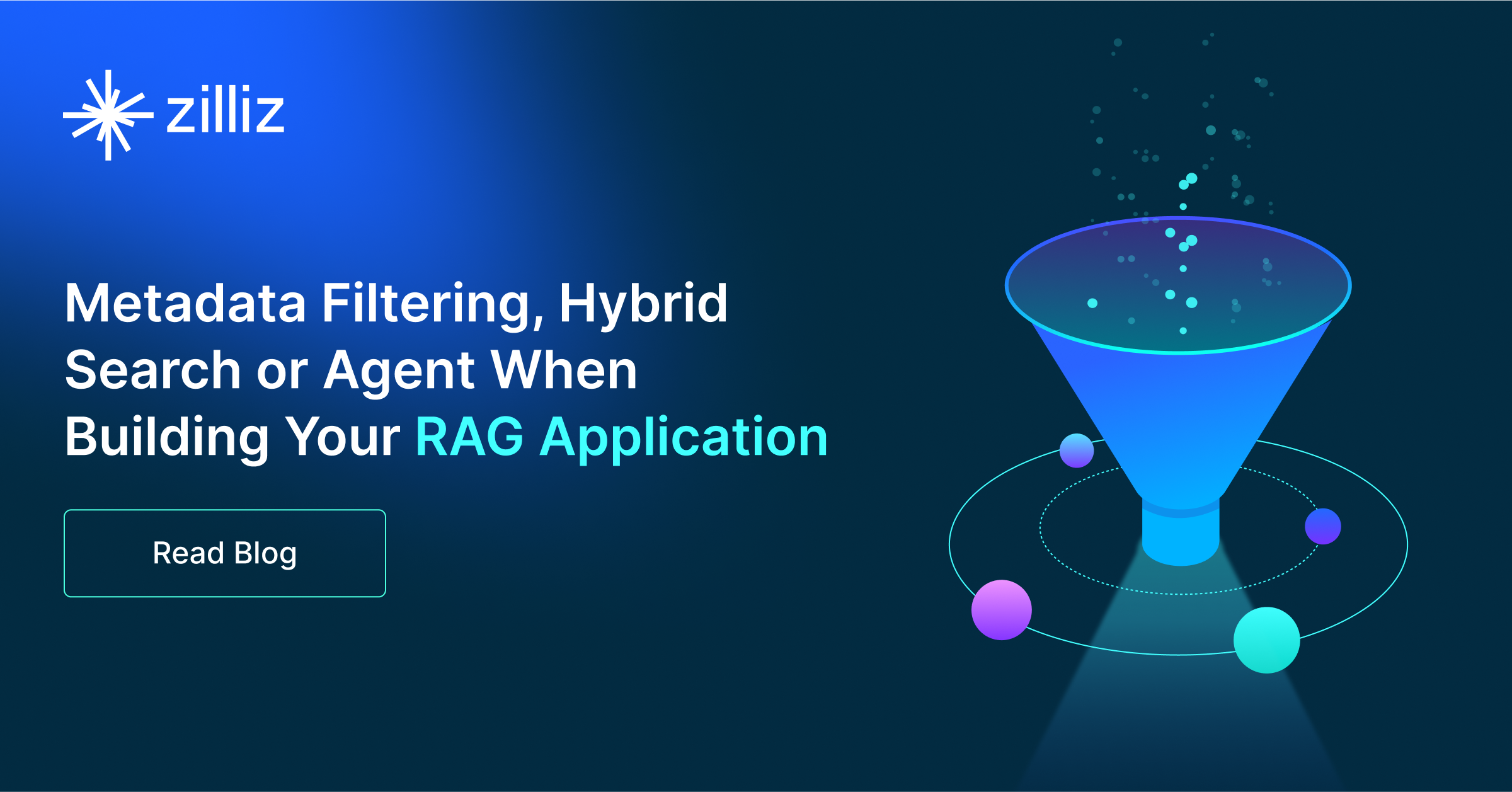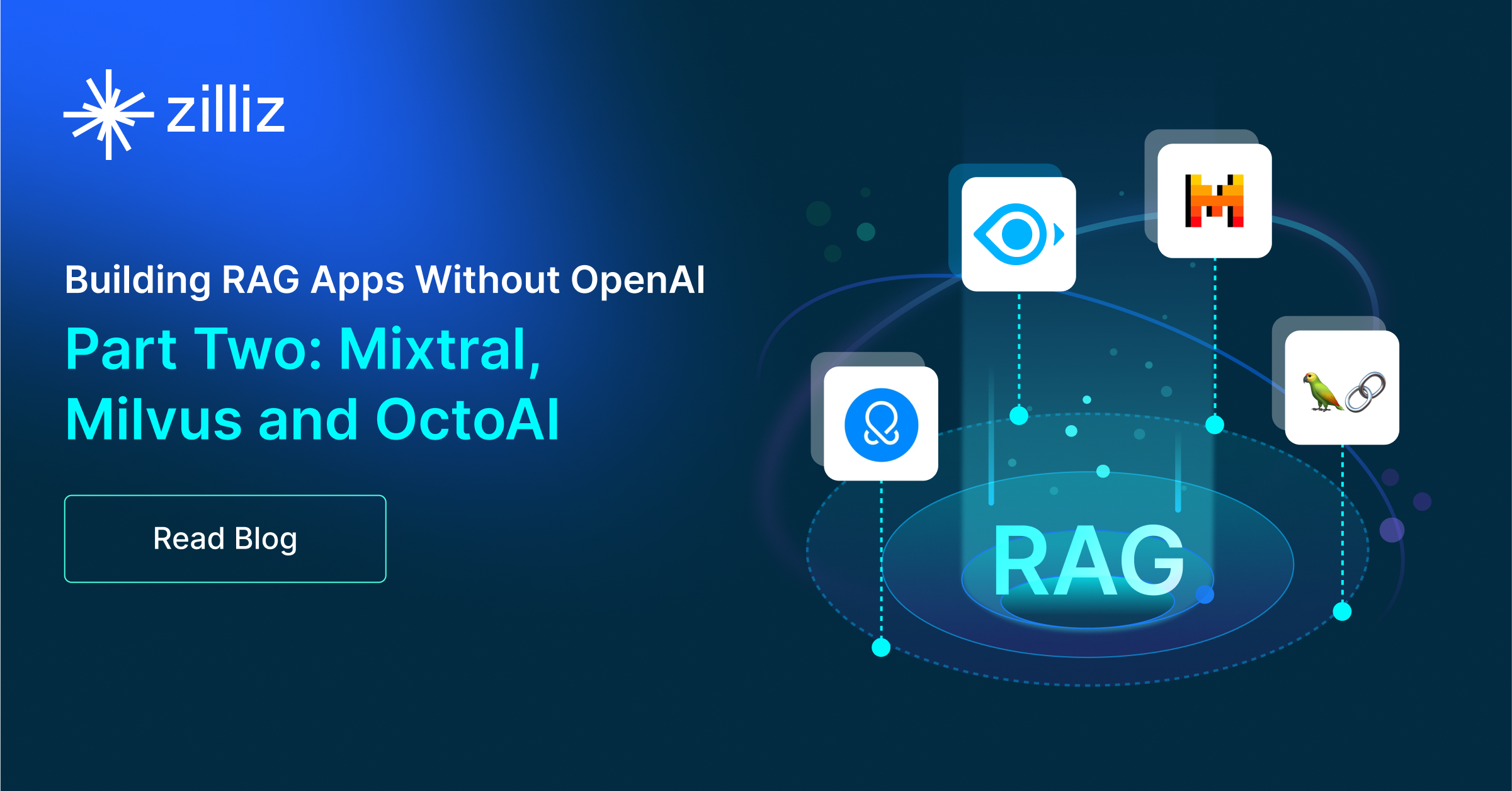Build RAG Chatbot with LangChain, Milvus, NVIDIA Deepseek R1, and IBM slate-125m-english-rtrvr
Introduction to RAG
Retrieval-Augmented Generation (RAG) is a game-changer for GenAI applications, especially in conversational AI. It combines the power of pre-trained large language models (LLMs) like OpenAI’s GPT with external knowledge sources stored in vector databases such as Milvus and Zilliz Cloud, allowing for more accurate, contextually relevant, and up-to-date response generation. A RAG pipeline usually consists of four basic components: a vector database, an embedding model, an LLM, and a framework.
Key Components We'll Use for This RAG Chatbot
This tutorial shows you how to build a simple RAG chatbot in Python using the following components:
- LangChain: An open-source framework that helps you orchestrate the interaction between LLMs, vector stores, embedding models, etc, making it easier to integrate a RAG pipeline.
- Milvus: An open-source vector database optimized to store, index, and search large-scale vector embeddings efficiently, perfect for use cases like RAG, semantic search, and recommender systems. If you hate to manage your own infrastructure, we recommend using Zilliz Cloud, which is a fully managed vector database service built on Milvus and offers a free tier supporting up to 1 million vectors.
- NVIDIA Deepseek R1: This advanced AI model is designed for high-fidelity image synthesis and enhancement, leveraging NVIDIA’s cutting-edge graphics technology. With its ability to generate realistic visuals and improve image quality, Deepseek R1 is ideal for applications in gaming, film production, and virtual reality, where lifelike graphics are paramount.
- IBM slate-125m-english-rtrvr: This model is designed for fine-tuning English text retrieval tasks, leveraging a slim and efficient architecture. Its strength lies in fast processing and high accuracy, making it ideal for applications that require quick and relevant information retrieval from large text datasets. Use cases include document search engines, chatbots, and content recommendation systems.
By the end of this tutorial, you’ll have a functional chatbot capable of answering questions based on a custom knowledge base.
Note: Since we may use proprietary models in our tutorials, make sure you have the required API key beforehand.
Step 1: Install and Set Up LangChain
%pip install --quiet --upgrade langchain-text-splitters langchain-community langgraph
Step 2: Install and Set Up NVIDIA Deepseek R1
pip install -qU "langchain-nvidia-ai-endpoints"
import getpass
import os
if not os.environ.get("NVIDIA_API_KEY"):
os.environ["NVIDIA_API_KEY"] = getpass.getpass("Enter API key for NVIDIA: ")
from langchain.chat_models import init_chat_model
llm = init_chat_model("deepseek-ai/deepseek-r1", model_provider="nvidia")
Step 3: Install and Set Up IBM slate-125m-english-rtrvr
pip install -qU langchain-ibm
import getpass
import os
if not os.environ.get("WATSONX_APIKEY"):
os.environ["WATSONX_APIKEY"] = getpass.getpass("Enter API key for IBM watsonx: ")
from langchain_ibm import WatsonxEmbeddings
embeddings = WatsonxEmbeddings(
model_id="ibm/slate-125m-english-rtrvr",
url="https://us-south.ml.cloud.ibm.com",
project_id="<WATSONX PROJECT_ID>",
)
Step 4: Install and Set Up Milvus
pip install -qU langchain-milvus
from langchain_milvus import Milvus
vector_store = Milvus(embedding_function=embeddings)
Step 5: Build a RAG Chatbot
Now that you’ve set up all components, let’s start to build a simple chatbot. We’ll use the Milvus introduction doc as a private knowledge base. You can replace it with your own dataset to customize your RAG chatbot.
import bs4
from langchain import hub
from langchain_community.document_loaders import WebBaseLoader
from langchain_core.documents import Document
from langchain_text_splitters import RecursiveCharacterTextSplitter
from langgraph.graph import START, StateGraph
from typing_extensions import List, TypedDict
# Load and chunk contents of the blog
loader = WebBaseLoader(
web_paths=("https://milvus.io/docs/overview.md",),
bs_kwargs=dict(
parse_only=bs4.SoupStrainer(
class_=("doc-style doc-post-content")
)
),
)
docs = loader.load()
text_splitter = RecursiveCharacterTextSplitter(chunk_size=1000, chunk_overlap=200)
all_splits = text_splitter.split_documents(docs)
# Index chunks
_ = vector_store.add_documents(documents=all_splits)
# Define prompt for question-answering
prompt = hub.pull("rlm/rag-prompt")
# Define state for application
class State(TypedDict):
question: str
context: List[Document]
answer: str
# Define application steps
def retrieve(state: State):
retrieved_docs = vector_store.similarity_search(state["question"])
return {"context": retrieved_docs}
def generate(state: State):
docs_content = "\n\n".join(doc.page_content for doc in state["context"])
messages = prompt.invoke({"question": state["question"], "context": docs_content})
response = llm.invoke(messages)
return {"answer": response.content}
# Compile application and test
graph_builder = StateGraph(State).add_sequence([retrieve, generate])
graph_builder.add_edge(START, "retrieve")
graph = graph_builder.compile()
Test the Chatbot
Yeah! You've built your own chatbot. Let's ask the chatbot a question.
response = graph.invoke({"question": "What data types does Milvus support?"})
print(response["answer"])
Example Output
Milvus supports various data types including sparse vectors, binary vectors, JSON, and arrays. Additionally, it handles common numerical and character types, making it versatile for different data modeling needs. This allows users to manage unstructured or multi-modal data efficiently.
Optimization Tips
As you build your RAG system, optimization is key to ensuring peak performance and efficiency. While setting up the components is an essential first step, fine-tuning each one will help you create a solution that works even better and scales seamlessly. In this section, we’ll share some practical tips for optimizing all these components, giving you the edge to build smarter, faster, and more responsive RAG applications.
LangChain optimization tips
To optimize LangChain, focus on minimizing redundant operations in your workflow by structuring your chains and agents efficiently. Use caching to avoid repeated computations, speeding up your system, and experiment with modular design to ensure that components like models or databases can be easily swapped out. This will provide both flexibility and efficiency, allowing you to quickly scale your system without unnecessary delays or complications.
Milvus optimization tips
Milvus serves as a highly efficient vector database, critical for retrieval tasks in a RAG system. To optimize its performance, ensure that indexes are properly built to balance speed and accuracy; consider utilizing HNSW (Hierarchical Navigable Small World) for efficient nearest neighbor search where response time is crucial. Partitioning data based on usage patterns can enhance query performance and reduce load times, enabling better scalability. Regularly monitor and adjust cache settings based on query frequency to avoid latency during data retrieval. Employ batch processing for vector insertions, which can minimize database lock contention and enhance overall throughput. Additionally, fine-tune the model parameters by experimenting with the dimensionality of the vectors; higher dimensions can improve retrieval accuracy but may increase search time, necessitating a balance tailored to your specific use case and hardware infrastructure.
NVIDIA Deepseek R1 optimization tips
To optimize the NVIDIA Deepseek R1 for Retrieval-Augmented Generation (RAG), ensure that your input data is well-prepared and indexed for fast access, leveraging its caching capabilities. Utilize mixed-precision training to enhance performance while reducing memory usage, and experiment with different batch sizes to find the most efficient processing speed. Additionally, regularly monitor and fine-tune hyperparameters such as learning rate and dropout rates based on validation results to avoid overfitting. Implement asynchronous data loading to keep the GPU actively processing while managing I/O operations. Finally, streamline the architecture by pruning non-essential layers and optimizing the model's inference pipeline to enhance real-time retrieval performance.
IBM slate-125m-english-rtrvr optimization tips
To optimize the IBM slate-125m-english-rtrvr for Retrieval-Augmented Generation (RAG), ensure that your document retrieval system is fine-tuned with domain-specific data to improve relevance. Utilize embeddings effectively by implementing cosine similarity for efficient nearest neighbor searches, and consider applying caching mechanisms to store frequently accessed documents. Additionally, experiment with various query augmentation techniques, like rephrasing or adding related keywords, to enhance retrieval performance. Monitor and analyze retrieval metrics (such as precision and recall) to iteratively refine your setup, and if possible, implement an ensemble approach by integrating multiple retrieval models to boost diversity in retrieved content. Finally, regularly update your corpus to reflect current knowledge and trends.
By implementing these tips across your components, you'll be able to enhance the performance and functionality of your RAG system, ensuring it’s optimized for both speed and accuracy. Keep testing, iterating, and refining your setup to stay ahead in the ever-evolving world of AI development.
RAG Cost Calculator: A Free Tool to Calculate Your Cost in Seconds
Estimating the cost of a Retrieval-Augmented Generation (RAG) pipeline involves analyzing expenses across vector storage, compute resources, and API usage. Key cost drivers include vector database queries, embedding generation, and LLM inference.
RAG Cost Calculator is a free tool that quickly estimates the cost of building a RAG pipeline, including chunking, embedding, vector storage/search, and LLM generation. It also helps you identify cost-saving opportunities and achieve up to 10x cost reduction on vector databases with the serverless option.
 Calculate your RAG cost
Calculate your RAG cost
What Have You Learned?
By diving into this tutorial, you’ve unlocked the power of building a cutting-edge RAG system from the ground up! You learned how LangChain acts as the glue, orchestrating workflows and connecting components seamlessly. Its intuitive framework lets you design pipelines that fetch, process, and generate information with ease. Then there’s Milvus, your high-performance vector database hero, storing and retrieving embeddings at lightning speed—perfect for handling the dense representations of text generated by IBM’s slate-125m-english-rtrvr embedding model. Speaking of which, you saw how this compact yet mighty model transforms raw text into meaningful vectors, capturing semantic nuances so your system understands context like a pro. And let’s not forget the star of the show: NVIDIA’s Deepseek R1 LLM, which takes those retrieved insights and crafts coherent, human-like responses, turning data into actionable knowledge.
But wait—there’s more! You also picked up pro tips for optimizing your RAG pipeline, like balancing speed and accuracy when tuning retrieval parameters, and even discovered a free RAG cost calculator to estimate expenses as you scale. Now that you’ve seen how these pieces fit together—the framework, database, LLM, and embeddings—you’re ready to dream bigger. Imagine chatbots that answer like experts, search engines that read between the lines, or tools that turn chaos into clarity. The magic is in your hands. So go ahead—tweak, experiment, and innovate. Build something that wows users, solves real problems, and pushes what’s possible with AI. Your RAG journey is just beginning, and the future is wide open. Let’s get building! 🚀
Further Resources
🌟 In addition to this RAG tutorial, unleash your full potential with these incredible resources to level up your RAG skills.
- How to Build a Multimodal RAG | Documentation
- How to Enhance the Performance of Your RAG Pipeline
- Graph RAG with Milvus | Documentation
- How to Evaluate RAG Applications - Zilliz Learn
- Generative AI Resource Hub | Zilliz
We'd Love to Hear What You Think!
We’d love to hear your thoughts! 🌟 Leave your questions or comments below or join our vibrant Milvus Discord community to share your experiences, ask questions, or connect with thousands of AI enthusiasts. Your journey matters to us!
If you like this tutorial, show your support by giving our Milvus GitHub repo a star ⭐—it means the world to us and inspires us to keep creating! 💖
- Introduction to RAG
- Key Components We'll Use for This RAG Chatbot
- Step 1: Install and Set Up LangChain
- Step 2: Install and Set Up NVIDIA Deepseek R1
- Step 3: Install and Set Up IBM slate-125m-english-rtrvr
- Step 4: Install and Set Up Milvus
- Step 5: Build a RAG Chatbot
- Optimization Tips
- RAG Cost Calculator: A Free Tool to Calculate Your Cost in Seconds
- What Have You Learned?
- Further Resources
- We'd Love to Hear What You Think!
Content
Vector Database at Scale
Zilliz Cloud is a fully-managed vector database built for scale, perfect for your RAG apps.
Try Zilliz Cloud for Free


